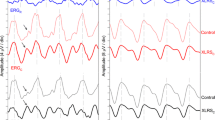Abstract
Neural adaptation to light stimulation in the dark-adapted retina can be demonstrated by double-flash electroretinography. The first flash is a conditioning flash, the second flash is the test flash. Interstimulus intervals are in the range of 0.2 to 30 seconds. Suppression of the response to the test flash is assumed not to be related to photopigment regeneration, as in normal human subjects the recovery after strong conditioning flashes is completed in about 2 seconds. In this paper we demonstrate the results of double-flash electroretinography on four patients, two of whom are brother and sister. Each of them showed a five- to ten-fold prolonged suppression time compared to normal measurements. Clinical aspects of all the patients were a stationary, though fluctuating, subnormal visual acuity of about 0.5, some photophobia, and difficulties in adaptation to changes in luminance levels. We assume that the PERRS indicates changes in the restorative reactions to phototransduction in the photoreceptors, or in the neural transmission mechanism, either in the rod-driven lateral inhibitory neural processes or in the cone-driven rod inhibitory processes, caused by a cone dysfunction.
Similar content being viewed by others
Abbreviations
- LED:
-
light emitting diode
- ERG:
-
electroretinography
- PERRS:
-
prolonged electro-retinal response suppression
- ISCEV:
-
International Society of Clinical Electrophysiology in Vision
References
Arden G, Granit R, Ponte F. Phase of suppression following each retinal b-wave in flicker. J Neurophysiol 1960; 23: 305–314.
Salinger WL, Lindsley DB. The suppression-recovery effect and visual adaptation in the cat. Vision Res 1971; 11: 1435–1444.
Schneider T, Zrenner E. Double-flash response in different retinal layers. Ophthalmic Res 1987; 19: 193–199.
Lützow AV, Wündsch L. Grenzen der zeitlichen Summation in Doppelreiz-ERG des Kaninchens. Vision Res 1967; 7: 565–571.
Schulze J, Bedderman F. Remarkable differences in double-flash response in rod-dominated and mixed retina. Vision Res 1971; 11: 1221.
Gottlob I, Wündsch L, Pflug R. Possible role of amacrine cells in the generation of the mammalian ERG b-wave. Doc Ophthalmol 1985; 61: 55–63.
Wagman IH, Waldman J, Naidoff D, Feinschil LB, Cahan R. The recording of the electroretinogram in humans and in animals. Am J Ophthalmol 1954; 38: 60–69.
Schweitzer NMJ, Troelstra A. The recovery of the b-wave in electroretinography during dark-adaptation. Vision Res 1964; 4: 345–353.
Kooijman AC, Zwarts MJ, Damhof A. Double-flash electroretinography in human eyes. Doc Ophthalmol 1990; 73: 377–385.
Zwarts MJ, Kooijman AC, Kalma L, Lakke JPWF. Double-flash electroretinography in Parkinson's Disease. Clin Vision Sci 1990; 6: 73–77.
Kooijman AC, Damhof A. ERG lens with built-in Ganzfeld light source for stimulation and adaptation. Invest Ophthalmol Vis Sci 1980; 19: 315–318.
Kooijman AC. The homogeneity of the retinal illumination is restricted by some ERG lenses. Invest Ophthalmol Vis Sci 1986; 27: 370–375.
Kooijman AC, Witmer FK. Light distribution on the retina of human and rabbit eyes: calculations and ‘in vitro’ measurements. J Opt Soc Am A 1986; 3: 2116–2120.
Marmor MF, Arden B, Nilsson SEG, Zrenner E. Standard for clinical electroretinography. Arch Ophthalmol 1989; 107: 816–819.
Jaeger W, Krastel H. Paradoxe Verbesserung der Sehfunktionen durch Reduktion der Beleuchtung bei Patienten mit Fundusdystrophien. Ber Dtsch Ophthalmol Ges 1980; 77: 675–681.
Schneider T, Zrenner E. The influence of phosphodiesterase inhibitors on ERG and optic nerve response of the cat. Invest Ophthalmol Vis Sci 1986; 27: 1395–1403.
Zrenner E. Electrophysiological characteristics of the blue sensitive mechanism: test of a model of cone interaction under physiological and pathological conditions. Doc Ophthalmol Proc Ser 1982; 33: 103.
Zrenner E, Kramer W, Bittner Ch, Bopp M, Schlepper M. Rapid effects on colour vision, following intravenous injection of a new, non-glycoside positive inotropic substance (AR-L 115 BS). Doc Ophthalmol Proc Ser 1982; 33: 493.
Pugh Jr EN, Cobbs WH, Tanner JW. Phototransduction in Vertebrate Rods: The Electrophysiological Approach to the cGMP Cascade Theory. In: Committee on Vision, eds. Advances in Photoreception. Washington: National Academy Press, 1990: 59–77.
Author information
Authors and Affiliations
Rights and permissions
About this article
Cite this article
Kooijman, A.C., Houtman, A., Damhof, A. et al. Prolonged Electro-Retinal Response Suppression (PERRS) in patients with stationary subnormal visual acuity and photophobia. Doc Ophthalmol 78, 245–254 (1991). https://doi.org/10.1007/BF00165687
Accepted:
Issue Date:
DOI: https://doi.org/10.1007/BF00165687




